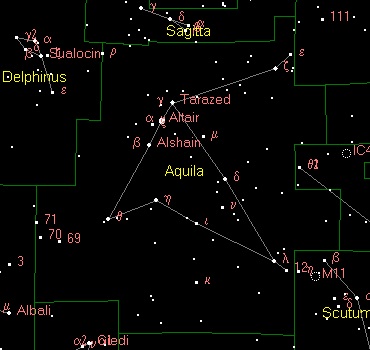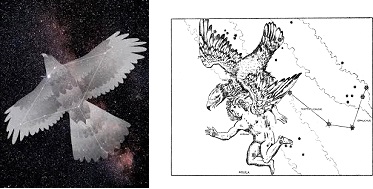
If you can notice a spread–winged posed eagle in the night sky, it is the constellation Aquila. Outstretching its wings through the glowing band of the Milky Way, it can be clearly spotted in the south in late summer. It belongs to the Hercules family of constellations and is clearly visible in September, around early evening. In Latin, Aquila means ‘eagle’, representing the eagle of the Roman god Jupiter. Originally, the constellation was first catalogued by the Greek astronomer Ptolemy in the 2nd century.One of the gigantic and extragalactic objects that Aquila holds is as huge as 10 billion light years known as Hercules–Corona Borealis Great Wall. This was discovered in November 2013 and is the most massive structure in the universe known to humans. There are two notable nebulae witnessed in the constellation; one was seen in 389 BC while the other was reported in 1918. Aquila consists of about 112 planetary nebulae, 133 dark nebulae, 3,762 galaxies, 4 quasars and 3 globular clusters.
. Aquila comprises of two very famous stars, the Altair and the Tarazed. The brightest star in this Constellation is the Altair, which is also the 12th brightest star in the sky. Tarazed is the second brightest star of Aquila.
- Altair (Alpha Aquilae) - Altair is the 12th brightest star in the sky with a visual magnitude of 0.77. It is also one of the closest stars to the earth and is hence, visible to the naked eye. Altair lies about 16.8 light years away.
- Alshain (Beta Aquilae) - Alshain is the seventh brightest star in Aquila. It has a visual magnitude of about 3.71 and is about 44.7 light years away from the earth. Alshain is also six times brighter than the Sun.
- Tarazed (Gamma Aquilae) - Tarazed is the second brightest star in Aquila. Tarazed is a class K giant with a visual magnitude of about 2.72 and is about 461 light years away. Tarazed is also 2,960 times brighter than the Sun.
- Deneb el Okab (Epsilon Aquilae) - It is about 154 light years away and is an orange K–type giant, also known as the barium star; as it contains a lot of barium and other heavy elements. Deneb el Okab has a visual magnitude of about 4.02.
- Deneb el Okab (Zeta Aquilae) - Zeta Aquilae is about 82.2 light years away, and is a white A–type dwarf. The main star in Zeta Aquilae has a visual magnitude of 2.99.
- Bezek (Eta Aquilae) - Eta Aquilae is a yellow–white super giant, which is about 1200 light years away from the earth. Its visual magnitude ranges between 3.5 to 4.4. This star is also 3,000 times brighter than the Sun.
However, other notable stars in this constellation include Tseen Foo (Theta Aquilae), Al Thalimain (Iota Aquilae), Al Thalimain (Lambda Aquilae), 15 Aquilae and Tso ke (Rho Aquilae).

Some of the deep sky objects included in the constellation are:
- Phantom Streak Nebula–NGC 6741: It is a planetary nebula and is about 7,000 light years away. Though it is classified as a planetary nebula, there are no planets responsible for its origination.
- NGC 6709: It is basically an open star cluster.
- NGC 6755: It is also an open star cluster and is located about 4.5 degrees to the west of Delta Aquilae.
- B143-4: It is a dark nebula which spans more than a degree in size and is located about 1.5 degrees to the west of Gamma Aquilae.
The other notable deep sky objects in this constellation are NGC 6803, NGC 6804, NGC 6891, NGC 6781, NGC 6751, NGC 6760, NGC 6749, NGC 6778 and NGC 6772.
This Constellation is located in the fourth quadrant of the northern hemisphere, and can be seen at latitudes between +90° and -75°. Also, Aquila occupies an area of 652 square degrees, making it the 22nd biggest star constellation in the sky.

Aquila is surrounded by constellations like Aquarius, Capricornus, Hercules, Delphinus, Ophiuchus, Sagitta, Scutum, Sagittarius and Serpens Cauda.
There are various myths associated to Aquila. The Greek mythology identifies Aquila as the eagle that carried Zeus’ thunderbolts and was once dispatched by the god to carry the young Trojan boy Ganymede whom Zeus desired, to Olympus to be the cup bearer of the gods. However, another story finds the eagle as guarding the arrow of Eros which hit Zeus and made him love–struck. Another myth states that Aquila represents Aphrodite disguised as an eagle, pretending to pursue Zeus in the form of a swan, so that Zeus’ love interest, the goddess Nemesis, would give him shelter.


